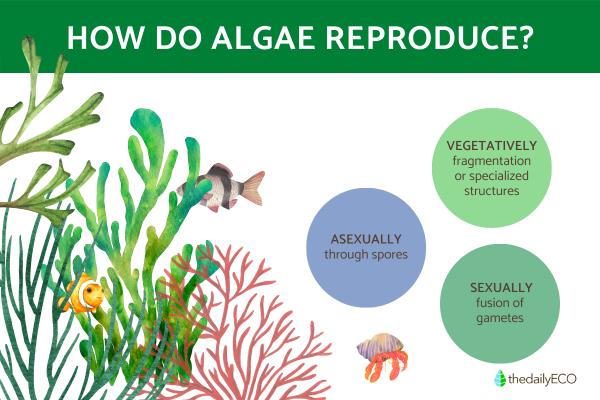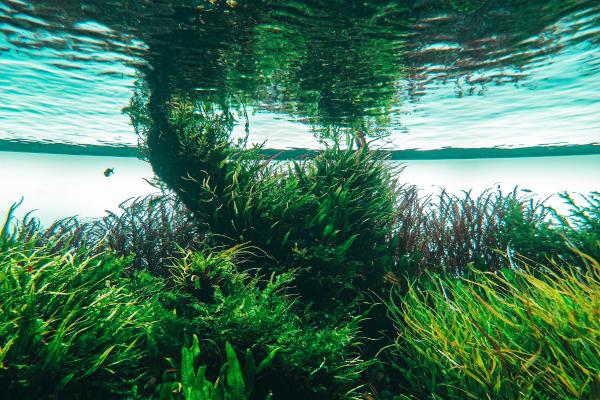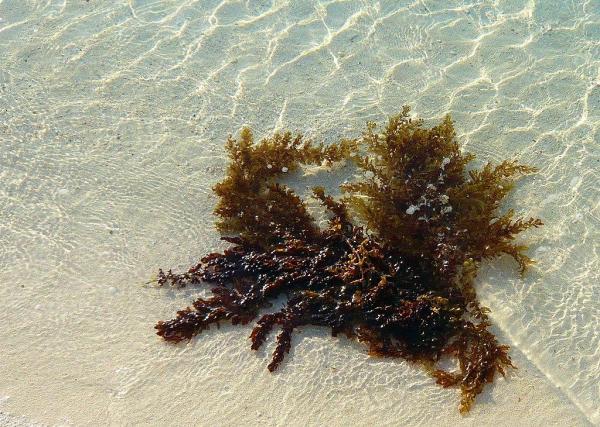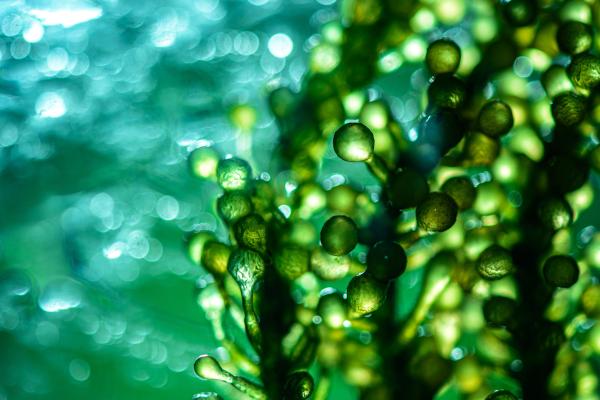
Algae are a diverse group of photosynthetic organisms that play a vital role in aquatic and terrestrial ecosystems. Their global success is due in part to their impressive adaptability, which extends to their diverse reproductive strategies. From simple fragmentation to complex sexual cycles, algae employ a variety of methods to propagate and thrive.
This article by thedailyECO explores how algae reproduce, covering the key methods, including vegetative, asexual, and sexual strategies, and examining how these processes contribute to their varied life cycles and ecological success.
How algae reproduce
Algae demonstrate an impressive diversity in their reproductive strategies, employing three main approaches: vegetative, asexual, and sexual reproduction.
These methods aren't mutually exclusive, in fact, most algal species exhibit reproductive plasticity, meaning they can switch between different modes depending on the circumstances. This flexibility is a key factor in their evolutionary success and widespread distribution across diverse aquatic and terrestrial habitats.
Vegetative reproduction:
It occurs through fragmentation, where parts of the parent organism break off and develop into new individuals. It is common in many seaweeds and filamentous algae. Some algae even have special structures, like tiny buds called gemmae or short chains of cells called hormogonia, specifically designed for vegetative reproduction.
Asexual reproduction:
This method also creates genetically identical offspring but uses spores instead of fragmentation. Spores are like tiny, self-contained packages designed for dispersal and survival.
There are different types of spores: zoospores can swim thanks to whip-like tails called flagella, while aplanospores can't move on their own. Autospores, on the other hand, are basically miniature versions of the parent cell.
Asexual reproduction often happens when conditions are good, allowing the algae to quickly multiply and take advantage of resources.
Sexual reproduction:
This is where things get more interesting from a genetic perspective. It involves combining genetic material from two parents. Specialized cells called gametes fuse together to form a zygote, which then develops into a new alga.
There are variations in how the gametes look: isogamous reproduction involves gametes that are identical in size and shape, anisogamous involves gametes of different sizes, and oogamous involves a large, non-motile egg and a small, motile sperm.
Sexual reproduction is often triggered by environmental stress or seasonal changes and results in increased genetic diversity within populations. This genetic variation is crucial for adaptation to changing environmental conditions.
What is the most common method of reproduction in algae?
While algae exhibit a diverse range of reproductive strategies, asexual reproduction through spore formation is generally considered the most common method.
The specific reproductive strategy employed by an alga is determined by a complex combination of environmental and internal factors. These include abiotic factors such as temperature, light availability, nutrient concentration, and salinity, as well as biotic factors like population density and interspecific interactions. Furthermore, the life cycle stage of the alga can also influence its reproductive mode.

Vegetative reproduction
Vegetative reproduction plays a crucial role in the propagation and proliferation of many algal species, offering a simple yet effective means of generating new individuals genetically identical to the parent.
This mode of reproduction bypasses the complexities of sexual reproduction and the energy investment associated with spore production in asexual strategies, allowing for rapid colonization of favorable habitats.
The most common form of vegetative reproduction in algae is fragmentation. Here, portions of the algal thallus, whether a single cell, a filament, or a more complex structure, separate and develop into independent individuals. This fragmentation can occur through various mechanisms, including physical breakage due to wave action, grazing, or other environmental disturbances. In filamentous algae, for example, a break in the filament can give rise to two or more new filaments, each capable of further growth and division. Similarly, in some larger, more complex algae, pieces of the thallus can detach and establish themselves elsewhere.
Beyond simple fragmentation, some algae have evolved specialized structures to enhance vegetative propagation.
- Gemmae: are small, multicellular propagules, are one such adaptation. These structures are often produced in specialized regions of the thallus and can detach and be dispersed by water currents or other means. Upon settling in a suitable location, a gemma can develop into a new alga.
- Hormogonia: are short filaments of cells, represent another specialized structure observed in certain algae, particularly cyanobacteria (often referred to as blue-green algae). These filaments can detach from the parent colony and migrate to new locations, where they can establish new colonies.
The significance of vegetative reproduction in algae cannot be overstated. It allows for rapid population growth in stable environments, enabling algae to quickly exploit available resources and dominate a habitat. This is particularly advantageous in environments where conditions are consistently favorable for growth.
Furthermore, vegetative reproduction contributes to the maintenance of genetic uniformity within a population, ensuring that advantageous traits are preserved and propagated. While sexual reproduction introduces genetic diversity, vegetative reproduction ensures the continued success of well-adapted genotypes in stable niches.
Did you know many species can create perfect copies of themselves? Discover more about this survival strategy.

Asexual reproduction of algae
Asexual reproduction is a dominant strategy employed by algae to proliferate rapidly and efficiently, particularly under favorable environmental conditions.
This mode of reproduction allows for the generation of numerous offspring genetically identical to the parent, maximizing the exploitation of resources and facilitating rapid colonization of new habitats. Unlike sexual reproduction, asexual reproduction bypasses the fusion of gametes, instead relying on the production and dispersal of spores.
Spores are specialized reproductive cells designed for dispersal and survival. They are typically small, unicellular structures encased in a protective cell wall, enabling them to withstand adverse conditions.
Algae exhibit a diversity of spore types, each adapted to specific environmental cues and dispersal mechanisms.
- Zoospores: are perhaps the most well-known type, are characterized by their motility. Equipped with flagella, whip-like appendages, zoospores can actively swim through the water column, facilitating dispersal and allowing them to reach suitable locations for settlement.
- Aplanospores: lack flagella and are non-motile. These spores rely on passive dispersal mechanisms, such as water currents or wind, to reach new habitats.
- Autospores: represent another category of asexual spores, which are essentially miniature versions of the parent cell. These spores are non-motile and are released from the parent cell upon maturation.
The production of asexual spores is often triggered by favorable environmental conditions, such as ample light, sufficient nutrients, and suitable temperature. Under these optimal conditions, algae can rapidly produce large numbers of spores, leading to a rapid increase in population size.
This ability to quickly exploit favorable conditions is a key advantage of asexual reproduction, allowing algae to outcompete other organisms and dominate a habitat. The sheer number of spores produced also increases the chances of successful colonization of new areas.
Want to understand how algae's microscopic messengers work? Our deep dive into spores reveals nature's clever design.

Sexual reproduction of algae
Sexual reproduction in algae introduces genetic diversity, a crucial factor for adaptation and long-term survival in changing environments.
Unlike asexual reproduction, which produces genetically identical offspring, sexual reproduction involves the fusion of gametes (sex cells) from two parents, resulting in offspring with a unique combination of genetic material.
This process generates variation within populations, providing the raw material for natural selection to act upon. This process fundamentally differs from vegetative and asexual reproduction in that it creates a new, genetically distinct individual.
Sexual reproduction in algae proceeds through three key phases:
1. Plasmogamy:
This is the fusion of the reproductive cells, or gametes. Depending on the morphology and motility of the gametes, different types of plasmogamy occur:
- Isogamy: the fusing gametes are identical in size and shape, typically both flagellated and motile.
- Anisogamy: the gametes are both motile (flagellated) but differ in size.
- Oogamy: the female gamete (egg) is significantly larger than the male gamete (sperm), and the sperm is usually motile while the egg is not. Sperm cells are also produced in greater numbers than egg cells.
2. Karyogamy:
Following plasmogamy, the nuclei of the two gametes fuse, resulting in the formation of a diploid zygote.
3. Meiosis:
This is a crucial chromosomal recombination process. Meiosis reduces the chromosome number from diploid (2n) to haploid (n), generating new gametes with diverse genetic combinations for the next reproductive cycle.
The timing of sexual reproduction is often linked to environmental cues, such as changes in temperature, light availability, nutrient levels, or even day length. These environmental signals can trigger the differentiation of vegetative cells into gametes.
In some species, sexual reproduction is tightly coupled with seasonal changes, ensuring that offspring are produced at a time when conditions are most favorable for their development and survival.
Stressful environmental conditions, such as nutrient limitation or desiccation, can also induce sexual reproduction as a survival mechanism, as the resulting genetic diversity increases the likelihood of producing offspring better suited to the altered environment.
Algae exhibit a great diversity of life cycles, with variations occurring during meiosis. These variations relate to the types of cells produced and whether there are one or more free-living stages during the cycle. These life cycles can be categorized as:
- Haplophase monogenetic cycle: meiosis occurs during the germination of the zygote, resulting in haploid individuals that make up the dominant phase of the life cycle.
- Diplophasic monogenetic cycle: meiosis results directly in haploid gametes. The dominant phase of the life cycle is diploid.
- Haplodiphlophasic digenetic cycle: this involves two distinct phases. A haploid gametophyte phase produces gametes through mitosis, and a diploid sporophyte phase produces spores through meiosis. This type of life cycle alternates between haploid and diploid generations.
The zygote, formed from the fusion of gametes, typically undergoes a period of dormancy before developing into a new alga. This dormant stage allows the zygote to survive unfavorable conditions, such as desiccation or freezing temperatures. Upon return to favorable conditions, the zygote germinates, giving rise to a new generation of algae.
Sexual reproduction, while often more energy-intensive than asexual reproduction, plays a vital role in the long-term success of algal populations. The genetic diversity generated through sexual reproduction allows populations to adapt to changing environments, resist diseases, and exploit new resources.
This adaptability is crucial for the survival of algae in the face of environmental challenges and contributes to their ecological success and widespread distribution.
Want to see how algae interact in their natural habitat? Dive into one of Earth's most dynamic underwater communities, kelp forests.

If you want to read similar articles to How Does an Algae Reproduce?, we recommend you visit our Biology category.
- Mikami, K. (2022). Research on the regulatory mechanism of algae reproduction under abiotic stress conditions. Plants, 11(3), 287. https://doi.org/10.3390/plants11030287
- Coelho, S. M., Peters, A. F., & Cock, J. M. (2023). Why reproductive systems matter for understanding algae. Journal of Phycology, 59(3), 439–447. https://doi.org/10.1111/jpy.13462
- Guillemin, M. L., Valero, M., Destombe, C., & Faugeron, S. (2015). On reproduction in red algae: Further research needed at the molecular level. Frontiers in Plant Science, 6, 93. https://doi.org/10.3389/fpls.2015.00093
- Kawai, H., & Sasaki, H. (1996). Reproductive biology of eukaryotic algae. In K. Sato, N. Wada, & T. Ishida (Eds.), Biodiversity and evolution (pp. 71–84). Springer. https://doi.org/10.1007/978-3-642-50133-3_5
- Coelho, S. M., Peters, A. F., & Cock, J. M. (2021). Evolution of life cycles and reproductive traits. Journal of Evolutionary Biology, 34(7), 992–1002. https://doi.org/10.1093/jeb/evab049